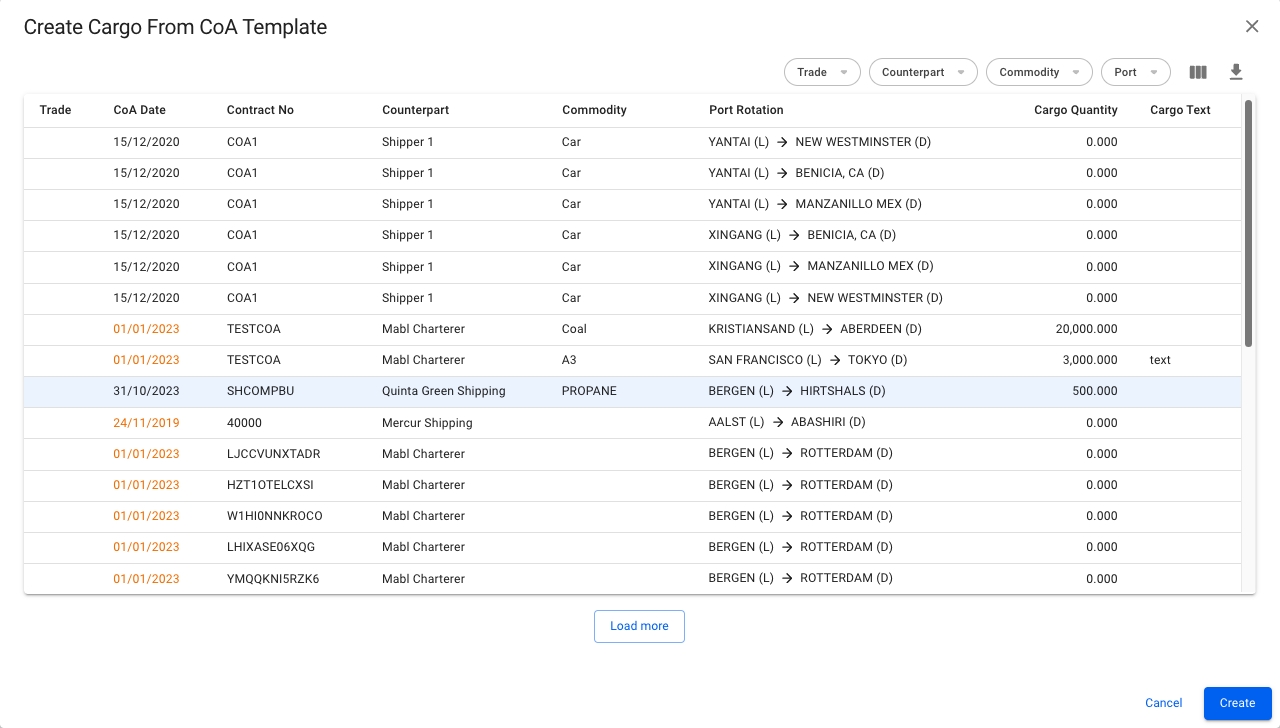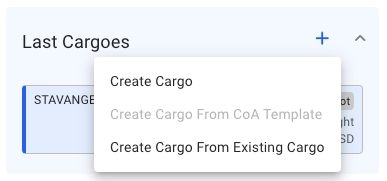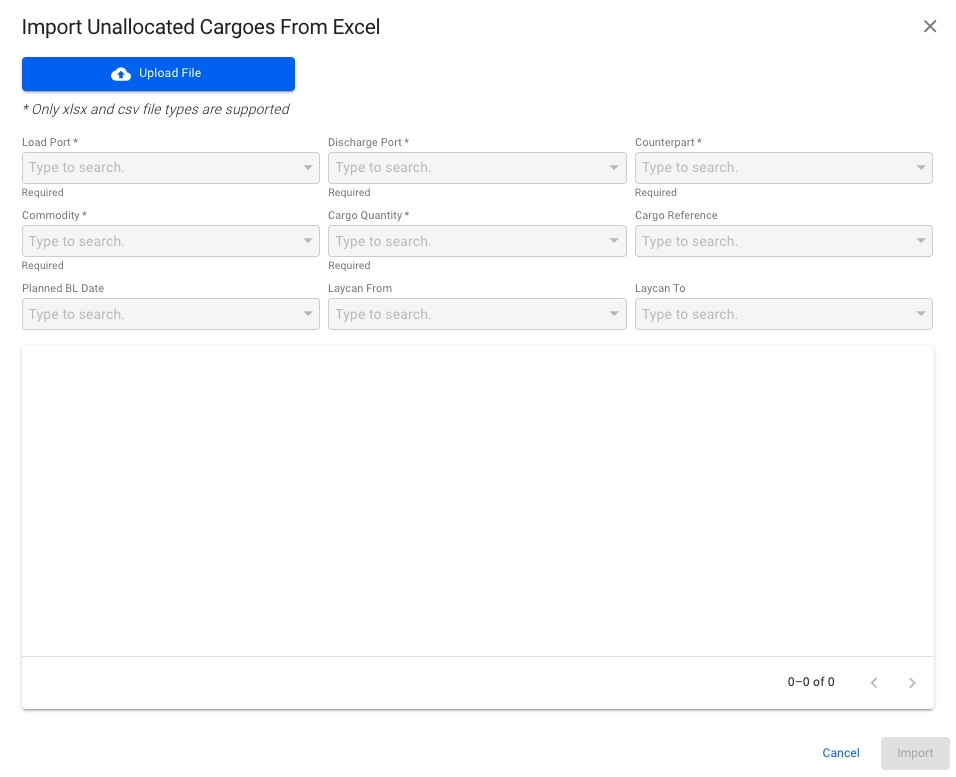A cargo can be created on a TC voyage either by using the Last Cargoes section in the Voyage drawer Overview tab, or by using the cargo list in the Cargo tab.
You cannot create a cargo from CoA templates
You cannot create a cargo if there are no load- or discharge port calls on the voyage
Even when we have the delivery/redelivery port calls
You need to create at least one loading- and discharging port calls on the voyage schedule (unique values)
You can only create cargoes with cargo ports based on the port calls in the voyage schedule
The port selectors on the upper-left side of the modal are restricted to only display these cargo ports (also with its attached terminals)
The following actions are disabled from the secondary drawer actions:
Unallocate Cargo
Allocoate Cargo
Relet
Transship
Preship
Transfer
In the FAS Cargo Management board, these following actions are disabled:
Dragging an unallocated cargo to a TC voyage
Dragging an allocated cargo on a TC voyage to Commitments
Dragging an allocated cargo from one TC voyage to another voyage (TC or not)
Open the Cargoes module from the menu on the left.
In the top right corner, click Create .
Select Create New Cargo.
In the modal, you can fill in the required fields and add any additional information about the new cargo.
Click Create.
Load Port
Discharge Port
Counterpart
Commodity And Sub-commodity
The new Create Cargo modal has a new design to increase the productivity while creating a cargo, is more user-friendly and has more useful features altogether. Click on the picture below to get a better view of the details:
Similar to the design above, we now have a new Create Cargo Port modal:
With the new multiple value component in the Create Cargo modal, you are now able to add multiple Load- and Discharge- cargo ports to the new cargo.
The fields are divided into 2 sections, while the 3rd section displays the Timeline component of the cargo ports that are added. In the Create Cargo Port modal, there are 2 sections, in which the 2nd one contains the Timeline.
It is possible to drag and drop the ports in the Timeline component to change the order of the cargo port rows, in both of the modals.
To see the new Create Cargo and Create Cargo Port modals for allocated cargoes, click here: Cargo Actions!
To efficiently create a cargo, and link them with CoAs, you can create a cargo based on a CoA Template. The CoA Templates are the template cargoes that are maintained in the CoA module.
Open the Cargoes module from the menu on the left.
In the top right corner, click Create .
Select Create New Cargo From CoA Template.
In the modal, select a CoA template to create the new cargo. The fields that are pre-filled are the ones that were filled in when creating the CoA itself, which the new cargo will inherit.
Click Create.
The modal is now draggable, making it easier to see the information "behind" the modal. Hover over the title or the top of the modal to activate it.
Looks and works quite similar to Create Voyage From Template.
Layout:
The Cargoes module is divided into the Allocated cargoes and the Unallocated cargoes. In each tab, you can filter the cargoes based on several key endpoints to effectively view the required information on your screen. There is a sort icon to the far right, with different options for sorting the list as well. You can read more here: Sorting and Filtering Lists.
Below you can click to read how to create different types of cargoes:
This modal has the same features as the Create Cargo modal, listed below. To create a new cargo port on a cargo, there is now a simple icon at the top of the Cargo Port Timeline section of the cargo drawer. However unlike the Create Cargo modal, Reason for Call is set to 'Loading' by default and is limited to only 'Loading' and 'Discharging' for cargo ports.To change the order of ports, you can use the drag and drop features inside the modal. To edit or delete an existing cargo port you can, in the Cargo Port Timeline section, look for the grey icons on each of the cargo port rows, to specifically focus on a cargo port of choice to make the changes. Read more about the features below.
To efficiently create a cargo, you can create a cargo based on an existing cargo.
Open the Cargoes module from the menu on the left.
In the top right corner, click Create .
Select Create New Cargo From Existing Cargo.
In the modal, select a cargo to create the new cargo
Click Create.
The modal can also be found in:
Voyage drawer, cargoes tab
Voyage drawer, cargoes list
Fleet Plans, Cargo Management
Fleet Plans, Cargoes
Capacity Plan
Cargoes
From this version, you can now can create cargo(es) by uploading/import straight from an Excel worksheet. In the Unallocated cargoes list, you can click on this import button:
Then, you can follow these steps:
Click on the Import button displayed above
A modal (or "dialog box") will pop-up:
All the fields are disabled until you upload/import a supported file (only .xlsx and .csv files). You can only import one file at a time, but one file can consist of many cargo rows!
You can proceed by clicking the blue Upload File button.
After choosing a supported file from you computer, you can view the filename to the right of the Upload File button, along with a "preview screen" below all the now-enabled fields:
All the required fields (*) must be filled in this step. As you go along with choosing the different fields from the dropdown menus, the "preview screen" will mark with a light-blue highlight on the fields have been selected. Meaning, you could upload your own customized Excel sheet with various header- and cell values, but you can then in the modal pick-and-choose which fields you actually want on the cargo, when creating it.
Tip: it might be a good idea to change/create Header values in your Excel sheet by matching them to what we display in the above modal. E.g. Counterpart, Commodity, Cargo Quantity, Load Port, etc.
Remember that only the first row of your Excel sheet are the Header values! The rest are the cell values within their respective columns.
After choosing the different values into the fields, and you are full-filling all the requirements below, then you can go ahead and create the cargo by clicking Import
You should now be able to see your newly created cargo at the top of the Unallocated cargoes list
We have two different types of validations in this modal. Either one, or both, of them will show up at the bottom of the modal, if encountering any inconsistencies while uploading:
(1) One is yellow-colored, and shows inconsistent data types in the cells of your Excel sheet:
This particular validation highlights the "Planned BL Date" column, and detects that two or more cells has inconsistent values within this column. E.g. one cell is read as a number value, while two cells are read as date values. In this case, the number-cell should be changed to a date value, so that the modal can read it properly as a date value. Make the change in your Excel sheet, and then re-upload the file.
This validation can highlight multiple columns with inconsistencies in data types, and not just one at a time.
(2) The other one is red-colored, and shows Reference or Master Data inconsistencies, i.e. data errors in your Excel sheet:
This particular validation highlights the "Commodity" column, and detects that "Row 2" within this column has a commodity named "Bananas" that does not exist in the system. In this case, you have two options:
a) replace "Bananas" with an existing Commodity in your Master Data, in your Excel sheet, and then re-upload the file
b) create a new Commodity "Bananas" in your Master Data first, and then re-upload the file.
This validation can highlight multiple columns and rows with inconsistencies in Master Data or references, and not just one column and/or row at a time.
Before actually creating a cargo by importing from an Excel worksheet, these requirements must be full-filled:
A supported Excel file must be uploaded/imported (only .xlsx and .csv files)
All required fields (*) must be filled in with supported values
No data types inconsistencies
No Master Data inconsistencies
No duplicate cargo references, or references to existing cargos
Once all of these requirements are full-filled, the Import button will be enabled, i.e. blue-colored, and you can then go ahead and create the cargo!









